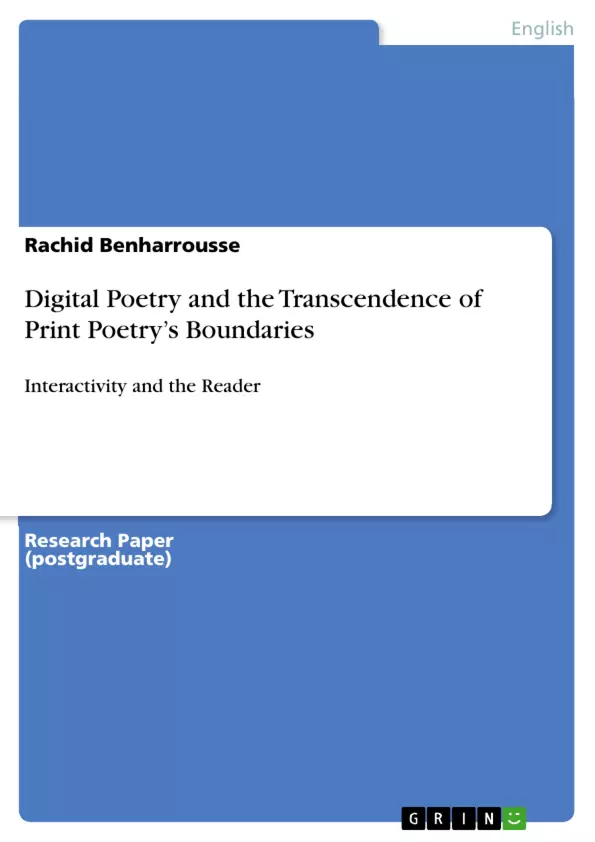In this monograph, I argue that English digital poetry has transcended the boundaries of print poetry through main interactivity. Thus, in chapter 1, I will present definitions of digital poetry and argue against their validity (Stefans, Jhave, Trimarco, Bohn, etc.); then I will present Funkhouser’s definition with the intention of demonstrating its accuracy. In chapter 2, I will argue that through interactivity, as a fundamental literary device and tool in digital literature as a whole, digital poetry is capable of transcending the boundaries of the print (juxtaposition, syntax, multipoeticality, etc,.). In chapter 3, I argue that the reader is less involved in the print medium than in digital medium wherein s/he is the primary force in the processes of editing, co-writing, choosing, and existing in the text. Thus, through these three chapters, I aim to prove that digital poetry has in fact transcended the boundaries of print poetry. One must note that the digital example in this paper cannot be printed; hence my use of only screenshots to make up for the inability to show them in their original, digital form.
Table of Contents
- Introduction
- Chapter 1: Defining Digital Poetry
- Chapter 2: Transcending the Print through Interactivity
- Chapter 3: The Reader as the Sole Authority
Objectives and Key Themes
This paper explores the evolution of digital poetry and its unique features, particularly in comparison to print poetry. The author examines how digital poetry transcends the traditional boundaries of print media through interactivity and the reader's active involvement in the creative process.
- Defining digital poetry and its distinct characteristics
- The role of interactivity in digital poetry
- The empowerment of the reader as an active participant
- The transcendence of print poetry's limitations
- The potential of code as a universal language for digital literature
Chapter Summaries
The introduction presents a brief overview of digital literature, its growing presence in academia, and its unique challenges in translation. It also critiques the notion of English digital literature as "world literature" and explores the potential of code as a truly universal language.
Chapter 1 delves into the definition of digital poetry, highlighting its defining features and contrasting it with traditional print poetry.
Chapter 2 explores the concept of interactivity in digital poetry and its role in transcending the limitations of print media. The chapter analyzes how digital poetry allows readers to actively engage with the text in new and exciting ways.
Keywords
Digital poetry, print poetry, interactivity, reader engagement, digital literature, code, universal language, world literature, translation, innovation, originality.
- Quote paper
- Rachid Benharrousse (Author), 2018, Digital Poetry and the Transcendence of Print Poetry’s Boundaries, Munich, GRIN Verlag, https://www.grin.com/document/497534



